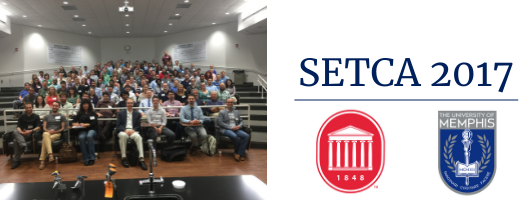Start Date
19-5-2017 1:00 PM
End Date
18-5-2017 1:00 PM
Description
Acid gases, especially CO2, play an important role in a range of large-scale energy applications. Acid gas conversion can make use of reactive sorbents and catalysts, but these materials must not substantially degrade under operating conditions. Metal oxides, metal organic frameworks, and clays may be used for these purposes, but interactions of acid gases with these complex materials are poorly understood. In order to improve our understanding of such materials, we have been using electronic structure methods to better understand these interactions in terms of ‘physisorption’ and ‘chemisorption’ type processes. The interactions of CO2 with models of MOF-2 (M2BDC4 for M = Co2+, Cu2+, and Zn2+), Group II oxide nanoclusters, Group IV and Group VI transition metal oxide nanoclusters, and actinide oxides have been predicted with density functional theory benchmarked by correlated molecular orbital theory calculations at the CCSD(T) level. The results are being correlated in terms of molecular properties such as Lewis acidities, redox capability, bond energies, and complexation energies. The work is supported by the Department of Energy, Basic Energy Sciences EFRC (UNCAGE-ME) and Geochemistry programs.
Relational Format
Conference proceeding
Recommended Citation
Dixon, David A., "IL5. Interactions of CO₂ with metal organic frameworks and metal oxide nanoclusters" (2017). Southeast Theoretical Chemistry Association Meeting (SETCA). 11.
https://egrove.olemiss.edu/setca/2017/schedule/11
IL5. Interactions of CO₂ with metal organic frameworks and metal oxide nanoclusters
Acid gases, especially CO2, play an important role in a range of large-scale energy applications. Acid gas conversion can make use of reactive sorbents and catalysts, but these materials must not substantially degrade under operating conditions. Metal oxides, metal organic frameworks, and clays may be used for these purposes, but interactions of acid gases with these complex materials are poorly understood. In order to improve our understanding of such materials, we have been using electronic structure methods to better understand these interactions in terms of ‘physisorption’ and ‘chemisorption’ type processes. The interactions of CO2 with models of MOF-2 (M2BDC4 for M = Co2+, Cu2+, and Zn2+), Group II oxide nanoclusters, Group IV and Group VI transition metal oxide nanoclusters, and actinide oxides have been predicted with density functional theory benchmarked by correlated molecular orbital theory calculations at the CCSD(T) level. The results are being correlated in terms of molecular properties such as Lewis acidities, redox capability, bond energies, and complexation energies. The work is supported by the Department of Energy, Basic Energy Sciences EFRC (UNCAGE-ME) and Geochemistry programs.



Comments
Download includes an expanded abstract with collaborators, institutional affiliations and cited references.